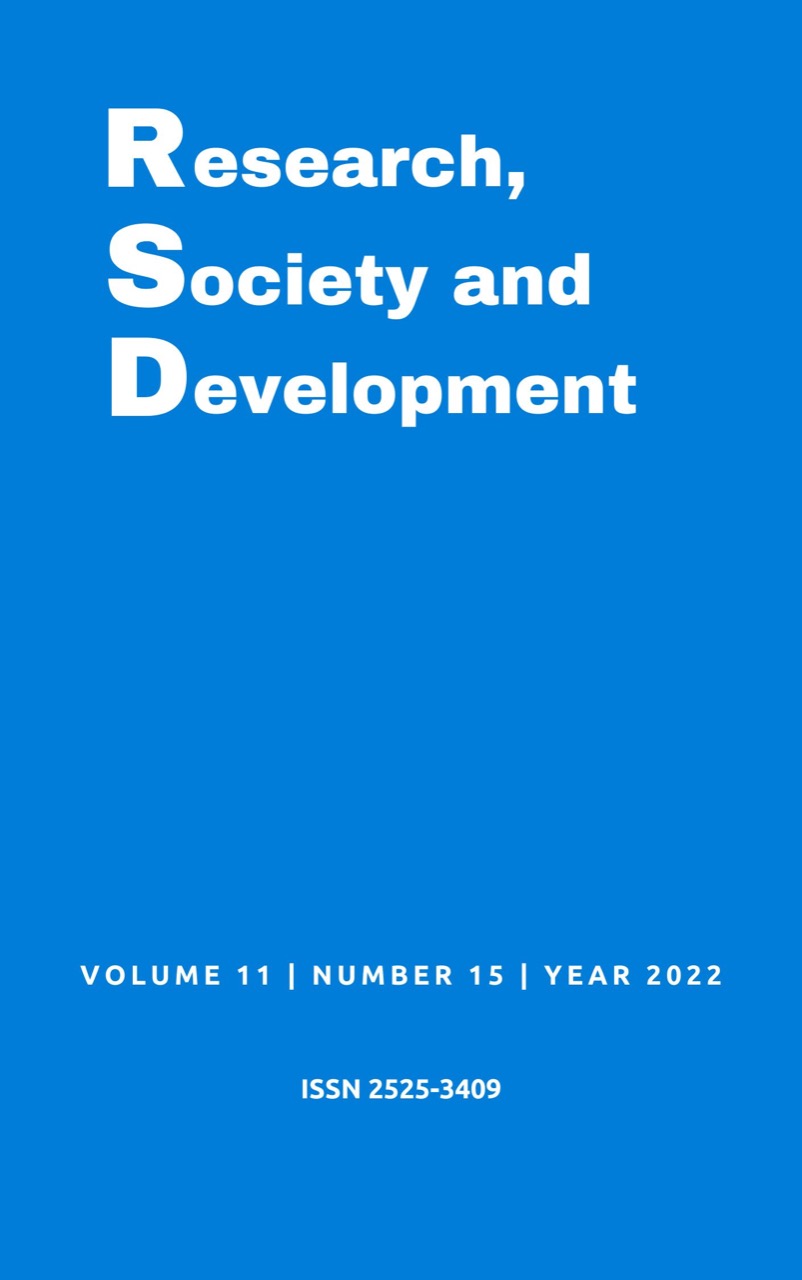Cosmetic biotechnology: Benefits of using fermented dermocosmetics in skin care during the Covid-19/SARS-CoV-2 pandemic
DOI:
https://doi.org/10.33448/rsd-v11i15.37503Keywords:
Biotechnology; Cosmetics; Hydroxy Acids; Skin diseases; Self care.Abstract
The insertion of applied biotechnology in the cosmetology industry has generated a great impact in several aspects, allowing cosmetic companies to discover, develop and produce components of cosmetic formulations and evaluating their activity on the skin, being an alternative tool for the development of actives with cell renewal action, preventive and in the fight against aging, in the treatment of disorders related to the facial skin. It aims to emphasize the need for facial self-care and to show the benefits of fermented dermocosmetics in the treatment of the skin due to the prolonged use of a protective mask. An online data survey was carried out from June to November 2022. Through the search on reliable scientific research platforms such as Google Scholar, Scientific Electronic Library Online (SciELO), Virtual Health Library (VHL), government websites, from the descriptors "biotechnology, cosmetics, hydroxy acids, skin diseases; skin care”. Prolonged use of the mask caused moisture, steam, dirt, sweat, saliva or mucus to be trapped between the mask and the skin causing irritation and sensitivity of the site, in addition to the friction of the mask on the face, thus being one of the factors that caused skin barrier damage and facial sensitization. It should be noted that using acids incorrectly could trigger other skin disorders, so it is always recommended to consult a health professional, such as a dermatologist, before applying the products. It is also worth mentioning that just the use of fermented dermocosmetics is not enough for healthy skin, but a set of actions to balance the body.
References
Abihpec (2022). Beautycare Brazil leva 52 empresas para a Beautyword Middle East 2022. Associação Brasileira da Indústria de Higiene Pessoal, Perfumaria e Cosméticos. https://abihpec.org.br/comunicado/beautycare-brazil-leva-52-empresas-para-a-beautyworld-middle-east-2022/
Abihpec (2022). A Indústria de Higiene Pessoal, Perfumaria e Cosméticos: Essencial para o Brasil. Associação Brasileira da Indústria de Higiene Pessoal, Perfumaria e Cosméticos. https://abihpec.org.br/site2019/wp-content/uploads/2021/04/Panorama_do_Setor_Atualizado_13.10.22.pdf
Basílio, R. (2022). Skincare fermentado: tudo o que você precisa saber sobre a tendência. Revista Claudia. https://claudia.abril.com.br/beleza/skincare-fermentado-tudo-o-que-voce-precisa-saber-sobre-a-tendencia/
Biotechtown (2019). Biotecnologia: descubra o que é e quais os seus usos. https://biotechtown.com/blog/o-que-e-biotecnologia/
Chaves, B., & Lobo, L. (2020). Biotecnologia: a linha do tempo. Blog do Profissão Biotec (ISSN 2675-6013), Ciência, Darling Lourenço, Fermentação, V.5. https://profissaobiotec.com.br/biotecnologia-linha-do-tempo/
Brasil. (2000). Ministério do Meio Ambiente. Convenção sobre Diversidade Biológica – CDB. Brasília: MMA. https://www.gov.br/mma/pt-br/textoconvenoportugus.pdf
Brasil (2005). Ministério da Saúde, RDC Nº 211, de 14 de julho de 2005. https://bvsms.saude.gov.br/bvs/saudelegis/anvisa/2005/rdc0211_14_07_2005.html
Brasil (2021). Como é transmitido?. Gov.br. https://www.gov.br/saude/pt-br/coronavirus/como-e-transmitido
Calixto, C. M. F., & Cavalheiro, É. T. G. (2012). Penicilina: efeito do acaso e momento histórico no desenvolvimento científico. Química Nova na escola, 34(3), 118-123. http://qnesc.sbq.org.br/online/qnesc34_3/03-QS-92-11.pdf
Chagas, S. Q. M. (2020). Análises de viabilidade e interesse na produção de ácido glicólico e compostos antioxidantes a partir da casca da banana. Repositório institucional UFF. https://app.uff.br/riuff/handle/1/16064
Dantas, H. L. de L., Costa, C. R. B., Costa, L. de M. C., Lúcio, I. M. L., & Comassetto, I. (2022). Como elaborar uma revisão integrativa: sistematização do método científico. Revista Recien - Revista Científica De Enfermagem, 12(37), 334–345. https://doi.org/10.24276/rrecien2022.12.37.334-345
Dias, I. D. S. (2018). A história do surgimento da microbiologia: fatos marcantes. Rio de Janeiro: Instituto de Microbiologia Paulo de Goés, Universidade Federal do Rio de Janeiro.
Emiliano, A., Guimarães, F., & Netz, D. J. A. (2012). Biotecnologia Na Obtenção De Ativos E Excipientes Cosméticos. http://siaibib01.univali.br/pdf/Aidiane%20Emiliano,%20Fatima%20Guimaraes.pdf
Faleiro, F. G., Andrade, S. D., Andrade, S. E. M., & Junior, F. B. R. (2011). Biotecnologia: uma visão geral. Biotecnologia: Estado de arte e aplicações na agropecuária. Planaltina, Embrapa, 13-29. https://www.researchgate.net/profile/Alves-Teixeira/publication/273662830_Chapter_13_Controle_biologico_de_insetos-praga/links/55082f7e0cf27e990e093496/Chapter-13-Controle-biologico-de-insetos-praga.pdf#page=14
Ferreira, P. (2020). Uso da máscara e agravamento da dermatite. Libbs-dermatologia. https://www.libbs.com.br/blog-dermatologia/uso-da-mascara-pode-desencadear-ou-agravar-a-dermatite/
Gomes, C., Silva, A. C., Marques, A. C., Sousa Lobo, J., & Amaral, M. H. (2020). Biotechnology applied to cosmetics and aesthetic medicines. Cosmetics, 7(2), 33. https://doi.org/10.3390/cosmetics7020033
Leite, D. S., & Munhoz, L. L. (2013). Biotecnologia e melhoramento das variedades de vegetais: Cultivares e Transgênicos. Veredas do Direito: Direito Ambiental e Desenvolvimento Sustentável, 10(19), 23-23. https://doi.org/10.18623/rvd.v10i19.301
Martins, R. de A. (2019). Aspectos Apriorísticos da Ciência: Lavoisier e a Lei da Conservação da Massa em Reações Químicas. In Objetivos humanísticos, conteúdos científicos: contribuições da história e da filosofia da Ciência para o ensino de Ciências. http://doi.org/10.7476/9786586221664.0002
Silva, L. F. M. D., Almeida, A. G. D. A., Pascoal, L. M., Santos Neto, M., Lima, F. E. T., & Santos, F. S. (2022). Lesões de pele por Equipamentos de Proteção Individual e medidas preventivas no contexto da COVID-19: revisão integrativa. Revista Latino-Americana de Enfermagem, 30. https://doi.org/10.1590/1518-8345.5636.3551
SPDV (s.d.). A pele. Sociedade Portuguesa de Dermatologia e Venereologia. https://www.spdv.pt/_a_pele
Teles, N., & Fonseca, M. J. (2019). A Importância do Microscópio Ótico na Revolução Científica - das Práticas Educacionais à Representação Museológica. História da Ciência e Ensino: construindo interfaces, 20, 126-140. https://doi.org/10.23925/2178-2911.2019v20espp126-140
Downloads
Published
How to Cite
Issue
Section
License
Copyright (c) 2022 Monica Chen; Jean Colacite

This work is licensed under a Creative Commons Attribution 4.0 International License.
Authors who publish with this journal agree to the following terms:
1) Authors retain copyright and grant the journal right of first publication with the work simultaneously licensed under a Creative Commons Attribution License that allows others to share the work with an acknowledgement of the work's authorship and initial publication in this journal.
2) Authors are able to enter into separate, additional contractual arrangements for the non-exclusive distribution of the journal's published version of the work (e.g., post it to an institutional repository or publish it in a book), with an acknowledgement of its initial publication in this journal.
3) Authors are permitted and encouraged to post their work online (e.g., in institutional repositories or on their website) prior to and during the submission process, as it can lead to productive exchanges, as well as earlier and greater citation of published work.

